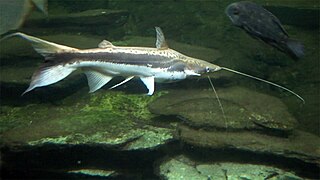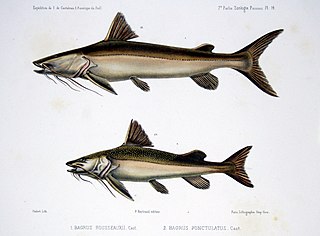
Hypostomus is a genus of catfish in the family Loricariidae. They are native to tropical and subtropical South America. H. plecostomus is the popular freshwater aquarium fish formerly known as Plecostomus plecostomus. The taxonomic structure of the Loricariidae is still being expanded by scientists. Hypostomus is a highly species-rich and widely distributed catfish genus.

Pseudoplatystoma is a genus of several South American catfish species of family Pimelodidae. The species are known by a number of different common names. They typically inhabit major rivers where they prefer the main channels and tend to stay at maximum depth, but some species can also be seen in lakes, flooded forests, and other freshwater habitats. They have robust bodies, and are important food fish. Recently, their population size has been on the drastic decline due to a variety of factors including overfishing and habitat destruction due to the construction of hydroelectric dams.

The Doradidae are a family of catfishes also known as thorny catfishes, raphael catfishes or talking catfishes. These fish are native to South America, primarily the Amazon basin and the Guianas.

The Cetopsidae are a small family of catfishes, commonly called the whale catfishes.

The Aspredinidae are a small South American family of catfishes also known as the banjo catfishes, with about 43 species.

Panaque nigrolineatus, the royal panaque, royal plec, or royal pleco, is an herbivorous freshwater armored catfish native to Brazil, Colombia and Venezuela where it occurs in the Orinoco and Amazon basins. It is known for being one of the few fish that digest wood. It grows to a length of 43.0 centimetres (16.9 in) and is a popular aquarium fish.

The loach catfishes are a family, Amphiliidae, of catfishes. They are widespread in tropical Africa, but are most common in streams at high elevations; most species are able to cling to rocks in fast-flowing streams. The 13 genera contain 68 species.
The Chiapas catfish, Lacantunia enigmatica, is an unusual species of catfish from the Usumacinta River basin in the Mexican state of Chiapas and in Guatemala. It was scientifically described in 2005 and placed in its own family Lacantuniidae. While discovery of an undescribed species of catfish is not uncommon, discovery of a new family of any vertebrate group is a rare event. The Chiapas catfish mainly feeds on crabs, prawns, small fish, and large, tough plant seeds. This catfish is commonly fished in its natural habitat, where it is known as madre de juil, which means "mother of Rhamdia".

Sorubim is a small genus of long-whiskered catfish native to tropical South America. A number of characteristics allows the differentiation of each species in the genus. Sorubim species are important food fish in South America and are highly significant to fisheries of some areas; however, harvests of these fish are not identified as much as other, more popular food fishes such as Colossoma, Arapaima, and Brachyplatystoma. Some species of this family are popular aquarium fish.

Phreatobius is a genus of very small catfishes from tropical South America.

Brachyplatystoma is a genus of catfish from the family Pimelodidae. As the occasionally used common name goliath catfishes indicates, this genus includes some of the largest species of catfish, including the piraíba, B. filamentosum, which reaches up to the region of 3.6 metres (12 ft) in length. Brachyplatystoma are found in the Amazon and Orinoco basins, and other tropical freshwater and brackish habitats in South America. Some species are migratory. These fish are important as food fish and, to some extent, aquarium fish.
Scoloplax is the only genus in the catfish family Scoloplacidae, the spiny dwarf catfishes.
Aguarunichthys is a genus of long-whiskered catfishes native to South America.
Paracanthopoma parva is a species of catfishes of the family Trichomycteridae. P. parva grows to about 2.7 centimetres (1.1 in) SL and is endemic to Brazil where it occurs in the Amazon and Essequibo River basins.

Bagarius is an Asian genus of catfishes of the family Sisoridae. It includes five to six extant species and potentially one extinct fossil species, B. gigas.

Pseudacanthicus is a genus of medium to large-sized suckermouth armored catfishes native to South America, where found in the Amazon and Orinoco basins, as well as rivers of the Guianas. They are primarily found in fast-flowing waters, sometimes relatively deep. They are sometimes kept in aquariums.
Micromyzon akamai is a species of catfish in the family Aspredinidae.

Goeldiella eques is a species of three-barbeled catfish that occurs in the Guianas and the Amazon basin of Brazil, Peru and Venezuela. This fish reaches a length of 28.9 centimetres (11.4 in) SL. It is the only species of its genus.
Cheirocerus eques, is a species of demersal catfish of the family Pimelodidae that is native to Amazon River basin of Brazil.
Cheirocerus goeldii, is a species of demersal catfish of the family Pimelodidae that is native to Purus River basin and Das Velhas River basin of Brazil and Peru.












